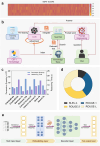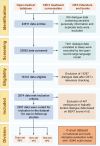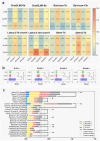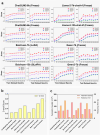eCBT-I dialogue system: a comparative evaluation of large language models and adaptation strategies for insomnia treatment
- PMID: 40764995
- PMCID: PMC12326588
- DOI: 10.1186/s12967-025-06871-y
eCBT-I dialogue system: a comparative evaluation of large language models and adaptation strategies for insomnia treatment
Abstract
Background: Traditional face-to-face mental health treatments are often limited by time and space. Thanks to the development of advanced large language models (LLMs), digital mental health treatments can provide personalized advice to patients and improve compliance. However, in the field of CBT-I, specialized, real-time interactive dialogue platforms have not been fully developed.
Methods: Our research team construct an eCBT-I intelligent dialogue system based on the RAG architecture, aiming to provide an example of the deep integration of CBT-I knowledge graphs and large language models. Furthermore, in order to optimize the performance of the system's core language generation module on the insomnia dialogue dataset, we systematically include eight mainstream large language models (ChatGLM2-6b, ChatGLM3-6b, Baichuan-7b, Baichuan-13b, Qwen-7b, Qwen2-7b, Llama-2-7b-chat-hf, and Llama-2-13b-chat-hf) and three adaptation strategies (LoRA, QLoRA, and Freeze). We screen the suitability of the three adaptation strategies for the eight major language models in the group, and thus determine the best adaptation method for each language model to maximize performance improvement. The eight best-adapted language models are then evaluated in three dimensions to compare their performance on the small sample sleep dialogue dataset and the C-eval dataset. All subjects that evaluated under experimental conditions are historical medical records and patients who did not exhibit delirium and had normal language expression abilities.
Results: Through the matching of model characteristics to adaptation strategies and the horizontal evaluation of multiple models, we compare the contribution of different fine-tuning strategies to the performance improvement of different language models on the small insomnia dialogue dataset, and finally determine that Qwen2-7b (Freeze) is the model with the best performance on the insomnia dialogue dataset.
Conclusions: This study effectively integrates the CBT-I knowledge graph with the large language model through the RAG architecture, which improves the professionalism of the eCBT-I intelligent dialogue system. The systematic fine-tuning method selection process and the confirmation of the optimal model not only improve the adaptability of the large language model in the CBT-I task, but also provide a useful paradigm for AI applications in medical subfields with resource constraints and difficulties in data collection, laying a solid foundation for more accurate and efficient digital CBT-I clinical practice in the future.
Keywords: Adaptation strategy; Large language models; Mental health; RAG architecture; eCBT-I.
© 2025. The Author(s).
Conflict of interest statement
Declarations. Conflict of interest: The authors declare that the research was conducted without any commercial or financial relationships that could be construed as potential conflicts of interest.
Figures




Similar articles
-
Network meta-analysis comparing the effectiveness of a prescription digital therapeutic for chronic insomnia to medications and face-to-face cognitive behavioral therapy in adults.Curr Med Res Opin. 2022 Oct;38(10):1727-1738. doi: 10.1080/03007995.2022.2108616. Epub 2022 Aug 23. Curr Med Res Opin. 2022. PMID: 35938209
-
Evaluating and Enhancing Japanese Large Language Models for Genetic Counseling Support: Comparative Study of Domain Adaptation and the Development of an Expert-Evaluated Dataset.JMIR Med Inform. 2025 Jan 16;13:e65047. doi: 10.2196/65047. JMIR Med Inform. 2025. PMID: 39819819 Free PMC article.
-
Development of a Voice-Activated Virtual Assistant to Improve Insomnia Among Young Adult Cancer Survivors: Mixed Methods Feasibility and Acceptability Study.JMIR Form Res. 2025 Mar 10;9:e64869. doi: 10.2196/64869. JMIR Form Res. 2025. PMID: 40063947 Free PMC article. Clinical Trial.
-
Psychological therapies for panic disorder with or without agoraphobia in adults: a network meta-analysis.Cochrane Database Syst Rev. 2016 Apr 13;4(4):CD011004. doi: 10.1002/14651858.CD011004.pub2. Cochrane Database Syst Rev. 2016. PMID: 27071857 Free PMC article.
-
Implementing Large Language Models in Health Care: Clinician-Focused Review With Interactive Guideline.J Med Internet Res. 2025 Jul 11;27:e71916. doi: 10.2196/71916. J Med Internet Res. 2025. PMID: 40644686 Free PMC article. Review.
References
-
- Riemann D, Benz F, Dressle RJ, et al. Insomnia disorder: state of the science and challenges for the future. J Sleep Res. 2022;31(4):e13604. - PubMed
-
- Taylor DJ, Lichstein KL, Durrence HH. Insomnia as a health risk factor. Behav Sleep Med. 2003;1(4):227–47. - PubMed
-
- Wickwire EM, Shaya FT, Scharf SM. Health economics of insomnia treatments: the return on investment for a good night’s sleep. Sleep Med Rev. 2016;30:72–82. - PubMed
Publication types
MeSH terms
Grants and funding
LinkOut - more resources
Full Text Sources
Medical
Research Materials
Miscellaneous

